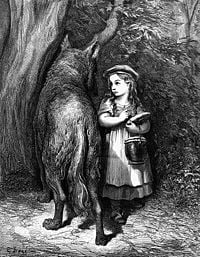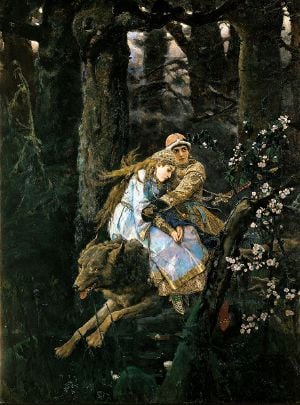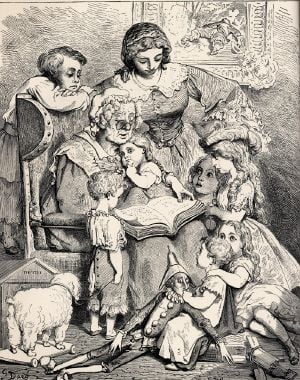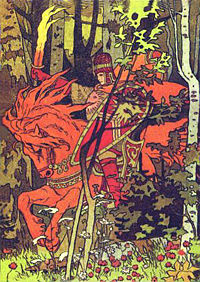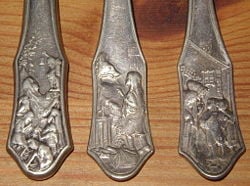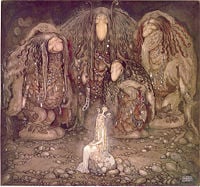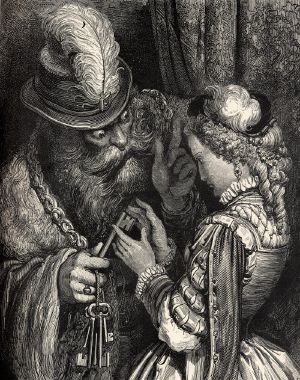Fairy tale
A fairy tale is a story featuring folkloric characters such as fairies, goblins, elves, trolls, witches, giants, and talking animals, and usually enchantments. Fairy tales often involve a far-fetched sequence of events that ultimately progress to a satisfying conclusion while teaching a moral lesson.
Unlike legends and epics, they usually do not contain more than superficial references to religion and actual places, persons, and events; they take place "once upon a time" rather than in actual times.[1]
Fairy tales are found in oral folktale and in literary form. The history of the fairy tale is particularly difficult to trace, because only the literary forms can survive. Still, the evidence of literary works at least indicates that fairy tales have existed for thousands of years, although not perhaps recognized as a genre; the name "fairy tale" was first ascribed to them by Madame d'Aulnoy. Literary fairy tales are found over the centuries throughout the world, and when folklorists collected them, they found fairy tales in every culture.
The older fairy tales were intended for an audience of adults as well as children, but they were associated with children as early as the seventeenth century; the Brothers Grimm titled their collection Children's and Household Tales, and the link with children has only grown stronger with time.
Folklorists have classified fairy tales in various ways. Among the most notable are the Aarne-Thompson classification, and the morphological analysis of Vladimir Propp.
Defining marks
Although the fairy tale is a clearly distinct genre, the definition that marks a work as a fairy tale is a source of considerable dispute.[2] Vladimir Propp, in his Morphology of the Folktale, criticized the common distinction between "fairy tales" and "animal tales" on the grounds that many tales contained both fantastic elements and animals.[3] To select works for his analysis, Propp used all Russian folktales classified as Aarne-Thompson 300-749—in a cataloging system that made such a distinction—to gain a clear set of tales.[4] His own analysis identified fairy tales by their plot elements, but that in itself has been criticized, as the analysis does not lend itself easily to tales that do not involve a quest, and furthermore, the same plot elements are found in non-fairy tale works.[5]
One universally agreed-on factor is that the nature of a tale does not depend on whether fairies appear in it. Many people, including Angela Carter in her introduction to the Virago Book of Fairy Tales, have noted that a great many of so-called fairy tales do not feature fairies at all.[6] This is partly because of the history of the English term "fairy tale" which derives from the French phrase contes de fée, and was first used in the collection of Madame D'Aulnoy in 1697.[7]
As Stith Thompson and Carter herself point out, talking animals and the presence of magic seem to be more common to the fairy tale than fairies themselves. However, the mere presence of animals that talk does not make a tale a fairy tale, especially when the animal is clearly a mask on a human face, as in fables.[8]
J. R. R. Tolkien, in his essay "On Fairy-Stories," agreed with the exclusion of "fairies" from the definition, and defined fairy tales as stories about the adventures of men in Faërie, the land of fairies, dwarves, elves, and not only other magical species but many other marvels.[9] However, in the same essay, by that very definition, he excludes tales that are often considered fairy tales, citing as an example "The Monkey's Heart," which Andrew Lang included in The Lilac Fairy Book.[8] Other tales that include no magic but are often classified as fairy tales include "What Is the Fastest Thing in the World?" and "Catskin."
Some folklorists prefer to use the German term Märchen to refer to the genre, a practice given weight by the definition of Thompson in his 1977 edition of The Folktale: "a tale of some length involving a succession of motifs or episodes. It moves in an unreal world without definite locality or definite creatures and is filled with the marvelous. In this never-never land, humble heroes kill adversaries, succeed to kingdoms and marry princesses."[10] The characters and motifs of fairy tales are simple and archetypal: princesses and goose-girls; youngest sons and gallant princes; ogres, giants, dragons, and trolls; wicked stepmothers and false heroes; fairy godmothers and other magical helpers, often talking horses, or foxes, or birds; glass mountains; and prohibitions and breaking of prohibitions.[11] Italo Calvino cited the fairy tale as a prime example of "quickness" in literature, because of the economy and concision of the tales.[12]
History of the genre
Originally, stories we would now call fairy tales were merely a kind of tale, not marked out as a separate genre. The German term "Märchen" means, literally, "tale" rather than any specific type. The genre itself was first marked out by writers of the Renaissance, who began to define a genre of tales, and became stabilized through the works of many writers, becoming an unquestioned genre in the works of the Brothers Grimm.[13] In this evolution, the name was coined when the précieuses took up writing literary stories; Madame d'Aulnoy invented the term contes de fée, or fairy tale.[14]
Prior to the definition of the genre of fantasy, many works that would now be classified as fantasy were termed "fairy tales," including Tolkien's The Hobbit, George Orwell's Animal Farm, and L. Frank Baum's The Wonderful Wizard of Oz.[15] Indeed, Tolkien's "On Fairy-Stories" includes discussions of world-building considered a vital part of fantasy criticism. Although fantasy, particularly in the sub-genre fairytale fantasy, draws heavily on fairy tale motifs,[16] the genres are now regarded as distinct.
Folk and literary
The fairy tale, as told orally, is a sub-class of the folktale. From this form, many writers have written down forms of fairy tales, often with considerable modification. These are the literary fairy tales, or Kunstmärchen.[7] The oldest forms, from Panchatantra to the Pentamerone, show stylistic evidence of considerable reworking from the oral form.[17] The Brothers Grimm were among the first to try to preserve the features of oral tales, and even so, they considerably reworked the fairy tales to fit the written form.[18]
Literary fairy tales and oral fairy tales freely exchanged plots, motifs, and elements with each other and with the tales of foreign lands.[19] Various folklorists of the eighteenth century attempted to recover the "pure" folktale, uncontaminated by literary versions; but while oral fairy tales likely existed for thousands of years prior to their literary forms, no such pure folktales exist–nor do pure literary fairy tales which do not drawing on folk tradition.[20] Once literary forms of the fairy tale existed, forms of transmission can be impossible to trace; oral story-tellers may even seek out readings of literary fairy tales in order to increase the number of stories and motifs they could use in their own tales.[21]
History
The fairy tale was part of an oral tradition; tales were told or enacted dramatically, rather than written down, and handed down from generation to generation. Because of this, the history of their development is necessarily obscure. Illiterate peoples, in particular, may have long told tales without there being any records of them.[22] The oldest known written fairy tales stem from ancient Egypt, c. 1300 B.C.E.,[23] and fairy tales appear, now and again, in written literature throughout literate cultures, as in The Golden Ass, which includes "Cupid and Psyche" (Roman, 100-200 C.E.),[24] or the Panchatantra (India 200-300 C.E.),[24] but it is unknown to what extent these reflect the actual folk tales even of their own time. The stylistic evidence indicates that these, and many later collections, reworked folk tales into literary forms.[25] What they do show is that the fairy tale has ancient roots, older than the Arabian Nights collection of magical tales (c. 1500 C.E.),[24] such as the Vikram and the Vampire, and Bel and the Dragon. Besides such collections and individual tales, in China, Taoist philosophers such as Liezi and Zhuangzi recounted fairy tales in their philosophical works.[26] In the broader definition of the genre, the first Western famous fairy tales are those of the Greek Aesop (sixth century B.C.E.).
Allusions to fairy tales appear plentifully in Geoffrey Chaucer's The Canterbury Tales, Edmund Spenser's The Faerie Queene, and the plays of William Shakespeare.[27] King Lear can be considered a literary variant of fairy tales such as "Water and Salt" and "Cap O' Rushes."[28] The tale itself resurfaced in Western literature in the sixteenth and seventeenth centuries, with The Facetious Nights of Straparola by Giovanni Francesco Straparola (Italy, 1550 and 1553),[24] which contains many fairy tales in its inset tales, and the Neapolitan tales of Giambattista Basile (Naples, 1634-1636),[24] which are all fairy tales.[29] Carlo Gozzi made use of many fairy tale motifs among his Commedia dell'Arte scenarios,[30] including among them one based on The Love For Three Oranges (1761).[31] Simultaneously, Pu Songling, in China, included many fairy tales in his collection, Strange Stories from a Chinese Studio (published posthumously, 1766).[26] The fairy tale itself became popular among the précieuses of upper-class France (1690-1710),[24] and among the tales told in that time were the ones of Jean de La Fontaine and the Contes of Charles Perrault (1697), who fixed the forms of Sleeping Beauty and Cinderella.[32] Although Straparola's, Basile's and Perrault's collections contain the oldest known forms of various fairy tales, on the stylistic evidence, all the writers rewrote the tales for literary effect.[33]
The first collectors to attempt to preserve not only the plot and characters of the tale, but also the style in which they were preserved, were the Brothers Grimm, who began by collecting German fairy tales; ironically enough, while their first edition (1812 & 1815)[24] remains a treasure for folklorists, they rewrote the tales in later editions to make them more acceptable, ensuring their sales and the later popularity of their work even as they strayed from their original intention.[34]
Such literary forms did not merely draw from the folktale, but also influenced folktales in turn. The Brothers Grimm rejected several tales for their collection, though told orally to them by Germans, because the tales derived from Perrault, and they concluded they were thereby French and not German tales; an oral version of "Bluebeard" was thus rejected, and the tale of "Briar Rose," clearly related to Perrault's "Sleeping Beauty," was included only because Jacob Grimm convinced his brother that the figure of Brynhild proved that the sleeping princess was authentically German folklore.[35]
The discussion on the origin of "Sleeping Beauty" reflected a belief common among folklorists of the nineteenth century that the folk tradition preserved fairy tales in forms from pre-history except when "contaminated" by such literary forms, leading people to tell inauthentic tales.[36] The rural, illiterate, and uneducated peasants, if suitably isolated, were the folk and would tell pure folk tales.[37] Sometimes they regarded fairy tales as a form of fossil, the remnants of a once-perfect tale.[38] However, further research has concluded that fairy tales never had a fixed form, and regardless of literary influence, the tellers constantly altered them for their own purposes.[39]
The work of the Brothers Grimm helped influence the rise of Romanticism, fueled by a strong sense of nationalism. Their view that the fairy tales of a country were particularly representative of its own national spirit would serve to influence other collectors in Europe, inspiring them to collect tales and seek those tales that would reflect their own national spirit, neglecting cross-cultural influence. Among those influenced by the Brothers Grimm were the Russian Alexander Afanasyev (first published in 1866),[24] the Norwegians Peter Christen Asbjørnsen and Jørgen Moe ( first published in 1845),[24] the Romanian Petre Ispirescu (first published in 1874), the English Joseph Jacobs (first published in 1890),[24] and Jeremiah Curtin, an American who collected Irish tales (first published in 1890).[40] Ethnographers collected fairy tales over the world, finding similar tales in Africa, the Americas, and Australia; Andrew Lang was able to draw on not only the written tales of Europe and Asia, but those collected by ethnographers, to fill his "colored" fairy books series.[41] They also encouraged other collectors of fairy tales, as when Yei Theodora Ozaki created a collection, Japanese Fairy Tales (1908), after encouragement from Lang.[42] Simultaneously, writers such as Hans Christian Andersen and George MacDonald continued the tradition of literary fairy tales. Andersen's work sometimes drew on old folktales, but more often deployed fairytale motifs and plots in new tales.[43] George MacDonald incorporated fairytale motifs both in new literary fairy tales, such as The Light Princess, and in works of the genre that would become fantasy, as in The Princess and the Goblin or Lilith.[44]
Cross-cultural transmission
Two theories of origins have attempted to explain the common elements in fairy tales found spread over continents. One is that a single point of origin generated any given tale, which then spread over the centuries; the other is that such fairy tales stem from common human experience and therefore can appear separately in many different origins.[45]
Fairy tales with very similar plots, characters, and motifs are found spread across many different cultures. Many researchers hold this to be caused by the spread of such tales, as people repeat tales they have heard in foreign lands, although the oral nature makes it impossible to trace the route except by inference.[46] Folklorists have attempted to determine the origin by internal evidence, which can not always be clear; Joseph Jacobs, comparing the Scottish tale The Ridere of Riddles with the version collected by the Brothers Grimm, The Riddle, noted that in The Ridere of Riddles one hero ends up polygamously married, which might point to an ancient custom, but in The Riddle, the simpler riddle might argue greater antiquity.[47]
Folklorists of the "Finnish" (or historical-geographical) school attempted to place fairy tales to their origin, with less than conclusive results.[48] Sometimes influence, especially within a limited area and time, is clearer, as when considering the influence of Perrault's tales on those collected by the Brothers Grimm. Little Briar-Rose appears to stem from Perrault's Sleeping Beauty, as the Grimms' tale appears to be the only independent German variant.[49] Similarly, the close agreement between the opening of Grimms' version of Little Red Riding Hood and Perrault's tale points to an influence–although Grimms' version adds a different ending (perhaps derived from The Wolf and the Seven Young Kids).[50] Occasionally, internal evidence points towards one source; not only is Duan Chengshi's Ye Xian the oldest known variant of Cinderella, but the value the tale places on small feet points to its being the origin of the others, reflecting the importance of tiny feet (causing the practice of footbinding) in Chinese culture.[51]
Fairy tales also tend to take on the color of their location, through the choice of motifs, the style in which they are told, and the depiction of character and local color.[52]
Association with children
Originally, adults were the audience of a fairy tale just as often as children. Literary fairy tales appeared in works intended for adults, but in the nineteenth and twentieth centuries the fairy tale came to be associated with children's literature.
The précieuses, including Madame d'Aulnoy, intended their works for adults, but regarded their source as the tales that servants, or other women of lower class, would tell to children.[53] Indeed, a novel of that time, depicting a countess's suitor offering to tell such a tale, has the countess exclaim that she loves fairy tales as if she were still a child.[54] Among the late précieuses, Jeanne-Marie Le Prince de Beaumont redacted a version of Beauty and the Beast for children, and it is her tale that is best known today.[55] The Brothers Grimm titled their collection Children's and Household Tales and rewrote their tales after complaints that they were not suitable for children.[56]
In the modern era, fairy tales were altered so that they could be read to children. The Brothers Grimm concentrated mostly on eliminating sexual references;[57] Rapunzel, in the first edition, revealed the prince's visits by asking why her clothing had grown tight, thus letting the witch deduce that she was pregnant, but in subsequent editions carelessly revealed that it was easier to pull up the prince than the witch.[58] On the other hand, in many respects, violence – particularly when punishing villains – was increased.[59] Other, later, revisions cut out violence; J. R. R. Tolkien noted that The Juniper Tree often had its cannibalistic stew cut out in a version intended for children.[60] The moralizing strain in the Victorian era so altered the classical tales to teach lessons, as when Cinderella was altered to contain temperance themes, that Charles Dickens protested, "In an utilitarian age, of all other times, it is a matter of grave importance that fairy tales should be respected."[61]
Psychoanalysts such as Bruno Bettelheim, who regarded the cruelty of older fairy tales as indicative of psychological conflicts, strongly criticized this expurgation, on the grounds that it weakened their usefulness to both children and adults as ways of symbolically resolving issues.[62]
The adaptation of fairy tales for children continues. Walt Disney's influential Snow White and the Seven Dwarfs was largely (although certainly not solely) intended for the children's market.[63] The anime Magical Princess Minky Momo draws on the fairy tale Momotarō.[64]
Contemporary tales
Literary
In contemporary literature, many authors have used the form of fairy tales for various reasons, such as examining the human condition from the simple framework a fairytale provides.[65] Some authors seek to recreate a sense of the fantastic in a contemporary discourse.[66] Some writers use fairy tale forms for modern issues;[67] this can include using the psychological dramas implicit in the story, as when Robin McKinley retold "Donkeyskin" as the novel Deerskin, with emphasis on the abusive treatment the father of the tale dealt to his daughter.[68] Sometimes, especially in children's literature, fairy tales are retold with a twist simply for comic effect, such as The Stinky Cheese Man by Jon Scieszka. A common comic motif is a world where all the fairy tales take place, and the characters are aware of their role in the story.[69]
Other authors may have specific motives, such as multicultural or feminist reevaluations of predominantly Eurocentric masculine-dominated fairy tales, implying critique of older narratives.[70] The figure of the damsel in distress has been particularly attacked by many feminist critics. Examples of narrative reversal rejecting this figure include The Paperbag Princess by Robert Munsch, a picture book aimed at children in which a princess rescues a prince, or Angela Carter's The Bloody Chamber, which retells a number of fairytales from a female point of view. An analogous use of the fairy tale can be seen in the works of Oscar Wilde who introduced homoerotic narratives—in particular a pederastic ethos—into a medium intended for the use of children through his The Happy Prince and Other Stories and A House of Pomegranates.[71]
One more unusual usage of the genre occurred in a military technology journal named Defense AT&L, which published an article in the form of a fairytale titled Optimizing Bi-Modal Signal/Noise Ratios. Written by Maj. Dan Ward (USAF), the story uses a fairy named Garble to represent breakdowns in communication between operators and technology developers.[72] Ward's article was heavily influenced by George MacDonald.
Other notable figures who have employed fairy tales include A. S. Byatt, Jane Yolen, Terri Windling, Donald Barthelme, Robert Coover, Margaret Atwood, Kate Bernheimer, Espido Freire, Tanith Lee, James Thurber, Robin McKinley, Kelly Link, Donna Jo Napoli, Cameron Dokey, Robert Bly, Gail Carson Levine, and Jasper Forde among others.
It may be hard to lay down the rule between fairy tales and fantasies that use fairy tale motifs, or even whole plots, but the distinction is commonly made, even within the works of a single author: George MacDonald's Lilith and Phantastes are regarded as fantasy, while his "The Light Princess," "The Golden Key," and "The Wise Woman" are commonly called fairy tales. The most notable distinction is that fairytale fantasies, like other fantasies, make use of novelistic writing conventions of prose, characterization, or setting.[73]
Film
Fairy tales have been enacted dramatically; records exist of this in commedia dell'arte,[74] and later in pantomime.[75] The advent of cinema has meant that such stories could be presented in a more plausible manner, with the use of special effects and animation; the Disney movie Snow White and the Seven Dwarfs in 1937 was a ground-breaking film for fairy tales and, indeed, fantasy in general.[76] Disney's influence helped establish this genre as children's movies, despite the fact that Snow White, as well as the company's other early feature-length films were originally intended for adults as well. They have been accused of simplifying the tales and creating the "fairy tale" ending, in which everything goes right, as opposed to the pain and suffering—and sometimes unhappy endings—of many folk fairy tales.[68]
Many filmed fairy tales have been made primarily for children, from Disney's later works to Aleksandr Rou's retelling of Vasilissa the Beautiful, the first Soviet film to use Russian folk tales in a big-budget feature.[77] Others have used fairy tale motifs to create new tales, as in the movies Labyrinth,[78] and My Neighbor Totoro.[79]
Other works have retold fairy tales for adults. The Company of Wolves, based on an Angela Carter story, retold the story of Little Red Riding Hood,[80] and Jean Cocteau's Beauty and the Beast retold the eponymous story.[81]. Pan's Labyrinth creates a new tale from fairy motifs, as does Princess Mononoke.[82]
Motifs
Many fairy tales have features in common with each other. Two of the most influential classifications are those of Antti Aarne, as revised by Stith Thompson into the Aarne-Thompson classification system, and Vladimir Propp's Morphology of the Folk Tale.
Aarne-Thompson
This system groups fairy and folk tales according to their overall plot. Common identifying features are picked out to decide which tales are grouped together. Much therefore depends on what features are regarded as decisive.
For instance, tales like Cinderella – in which a persecuted heroine, with the help of the fairy godmother or similar magical helper, attends an event (or three) in which she wins the love of a prince and is identified as his true bride – are classified as type 510, the persecuted heroine. Some such tales are "The Wonderful Birch," "Aschenputtel," "Katie Woodencloak," "The Story of Tam and Cam," Ye Xian, "Cap O' Rushes," "Catskin," "Finette Cendron," "Allerleirauh," and "Tattercoats."
Further analysis of the tales shows that in Cinderella, "The Wonderful Birch," "The Story of Tam and Cam," Ye Xian, and "Aschenputtel," the heroine is persecuted by her stepmother and refused permission to go to the ball or other event, and in "Finette Cendron" by her sisters and other female figures, and these are grouped as 510A; while in "Cap O' Rushes," "Catskin," and "Allerleirauh," the heroine is driven from home by her father's persecutions, and must take work in a kitchen elsewhere, and these are grouped as 510B. But in Katie Woodencloak, she is driven from home by her stepmother's persecutions and must take service in a kitchen elsewhere, and in Tattercoats, she is refused permission to go to the ball by her grandfather. Given these features common with both types of 510, Katie Woodencloak is classified as 510A because the villain is the stepmother, and Tattercoats as 510B because the grandfather fills the father's role.
The weakness of this system is its difficulty in classifying subportions of a tale as motifs. Rapunzel is type 310 (The Maiden in the Tower), but it opens with a child being demanded in return for stolen food, as does Puddocky; but Puddocky is not a Maiden in the Tower tale, while The Canary Prince, which opens with a jealous stepmother, is.
The system lends itself to emphasis on the common elements, to the extent that the folklorist describes The Black Bull of Norroway as the same story as Beauty and the Beast. This can be useful as a shorthand but can also erase the coloring and details of a story.[83]
Morphology
Vladimir Propp specifically studied a collection of Russian fairy tales when he first created his theories in the 1930s, but his analysis has been found useful for the tales of other countries.[84]
Having criticized Aarne-Thompson type analysis for ignoring what motifs did in stories, and because the motifs used were not clearly distinct,[85] he analyzed the tales by the function of each character and action each fulfilled, concluding that a tale was composed of 31 elements and eight character types. While the elements were not all required for all tales, when they appeared they did so in an invariant order–except that each individual element might be negated twice, so that it would appear three times, as when, in Brother and Sister, the brother resists drinking from enchanted streams twice, so that it is the third that enchants him.[86]
One such element is the donor who gives the hero magical assistance, often after testing him.[87] In The Golden Bird, the talking fox tests the hero by warning him against entering an inn and, after he succeeds, helps him find the object of his quest; in The Boy Who Drew Cats, the priest advised the hero to stay in small places at night, which protects him from an evil spirit; in Cinderella, the fairy godmother gives Cinderella the dresses she needs to attend the ball, as their mothers' spirits do in Bawang Putih Bawang Merah and The Wonderful Birch; in The Fox Sister, a Buddhist monk gives the brothers magical bottles to protect against the fox spirit. The roles can be more complicated.[88] In The Red Ettin, the role is split into the mother – who offers the hero the whole of a journey cake with her curse or half with her blessing – and when he takes the half, a fairy who gives him advice; in Mr Simigdáli, the sun, the moon, and the stars all give the heroine a magical gift. Characters who are not always the donor can act like the donor.[89] In Kallo and the Goblins, the villain goblins also give the heroine gifts, because they are tricked; in Schippeitaro, the evil cats betray their secret to the hero, giving him the means to defeat them. Other fairy tales, such as The Story of the Youth Who Went Forth to Learn What Fear Was, do not feature the donor. The donor is featured due to illegitimate causes.
Analogies have been drawn between this and the analysis of myths into the Hero's journey.[90]
This analysis has been criticized for ignoring tone, mood, characters and, indeed, anything that differentiates one fairy tale from another.[91]
Interpretations
Many variants, especially those intended for children, have had morals attached. Perrault concluded his versions with one, although not always completely moral: Cinderella concludes with the observation that her beauty and character would have been useless without her godmother, reflecting the importance of social connections.[92]
Many fairy tales have been interpreted for their (purported) significance. One mythological interpretation claimed that many fairy tales, including Hansel and Gretel, Sleeping Beauty, and The Frog King, all were solar myths; this mode of interpretation is rather less popular now.[93] Many have also been subjected to Freudian, Jungian, and other psychological analysis, but no mode of interpretation has ever established itself definitively.
Specific analyses have often been criticized for lending great importance to motifs that are not, in fact, integral to the tale; this has often stemmed from treating one instance of a fairy as the definitive text, where the tale has been told and retold in many variations.[94] In variants of Bluebeard, the wife's curiosity is betrayed by a blood-stained key, by an egg's breaking, or by the singing of a rose she wore, without affecting the tale, but interpretations of specific variants have claimed that the precise object is integral to the tale.[95]
Other folklorists have interpreted tales as historical documents. Many German folklorists, believing the tales to have been preserved from ancient times, used Grimms' tales to explain ancient customs.[96] Other folklorists have explained the figure of the wicked stepmother historically: many women did die in childbirth, their husbands remarried, and the new stepmothers competed with the children of the first marriage for resources.[97]
Compilations
Collections of fairy tales include:
- Panchatantra
- Giovanni Francesco Straparola
- Pentamerone by Giambattista Basile
- Contes de ma mère l'Oye by Charles Perrault
- Grimm's Fairy Tales
- Hans Christian Andersen, for Andersen fairy tales
- Joseph Jacobs, for collected fairy tales
- Ruth Manning-Sanders, for collected fairy tales
- Norske Folkeeventyr
- Narodnye russkie skazki
- Madame d'Aulnoy
- Popular Tales of the West Highlands by John Francis Campbell
- Andrew Lang's Fairy Books
- Fairy Tales, a book by E. E. Cummings
- Italian Folktales by Italo Calvino
- Legende sau basmele românilor by Petre Ispirescu
Notes
- ↑ Catherine Orenstein. Little Red Riding Hood Uncloaked: Sex, Morality, and the Evolution of a Fairy Tale. (ISBN 0465041256), 9.
- ↑ Heidi Anne Heiner, "What Is a Fairy Tale?" surlalunefairytales.com. Retrieved October 5, 2008.
- ↑ Vladimir Propp. Morphology of the Folk Tale. (University of Texas Press, 1968), 5
- ↑ Propp, 19.
- ↑ Steven Swann Jones. The Fairy Tale: The Magic Mirror of Imagination. (New York: Twayne Publishers, 1995), 15.
- ↑ Angela Carter. The Old Wives' Fairy Tale Book. (New York: Pantheon Books, 1990), ix
- ↑ 7.0 7.1 Terri Windling, "Les Contes de Fées: The Literary Fairy Tales of France"endicott-studio.com. Retrieved October 5, 2008.
- ↑ 8.0 8.1 J. R. R. Tolkien, "On Fairy-Stories" in The Tolkien Reader. (Del Rey, 1986), 15.
- ↑ Tolkien, 10-11.
- ↑ Stith Thompson. The Folktale. (1977), 8.
- ↑ A. S. Byatt, "Introduction" xviii, Maria Tatar, ed. The Annotated Brothers Grimm. (New York: W. W. Norton, ISBN 0393058484.
- ↑ Italo Calvino. Six Memoes for the Next Millennium. (New York: Vintage), 36-37
- ↑ Jack Zipes. The Great Fairy Tale Tradition: From Straparola and Basile to the Brothers Grimm. (New York: W. W. Norton, 2001), xi-xii
- ↑ Zipes, 858.
- ↑ Brian Attebery, "The Fantasy Tradition in Brazillian Literature," in The Fantasy Tradition in American Literature: From Irving to Le Guin. (Indiana Univ. Press, 1980), 83
- ↑ Philip Martin. The Writer's Guide of Fantasy Literature: From Dragon's Liar to Hero's Quest. (Watson-Guptill Publications, 2002), 38-42
- ↑ Swann Jones, 35.
- ↑ Attebery, 1980, 5
- ↑ Zipes, 2001, xii.
- ↑ Zipes, 2001, 846.
- ↑ Linda Degh, "What Did the Grimm Brothers Give To and Take From the Folk?," 73, in James M. McGlathery, ed., The Brothers Grimm and Folktale. (University of Illinois Press, 1988). ISBN 0252015495.
- ↑ Zipes, 2007, 2
- ↑ John Grant and John Clute. The Encyclopedia of Fantasy. "Fairytale," 331.
- ↑ 24.0 24.1 24.2 24.3 24.4 24.5 24.6 24.7 24.8 24.9 Heidi Anne Heiner, "Fairy Tale Timeline"surlalunefairytales.com. Retrieved October 5, 2008.
- ↑ Swann Jones, 35.
- ↑ 26.0 26.1 Moss Roberts, "Introduction," xviii, Chinese Fairy Tales & Fantasies. (Pantheon, 1980. ISBN 0394739949.)
- ↑ Zipes, 2007, 11.
- ↑ Soula Mitakidou and Anthony L. Manna, with Melpomeni Kanatsouli, Folktales from Greece: A Treasury of Delights. (Greenwood Village, CO: Libraries Unlimited, 2002), 100
- ↑ Swann Jones, 38.
- ↑ Terri Windling, White as Ricotta, Red as Wine: The Magic Lore of Italyendicott-studio.com. Retrieved October 5, 2008.
- ↑ Italo Calvino, Italian Folktales, 738
- ↑ Zipes, 2007, 38-42.
- ↑ Swann Jones, 38-39.
- ↑ Swann Jones, 40.
- ↑ G. Ronald Murphy. The Owl, The Raven, and the Dove: The Religious Meaning of the Grimms' Magic Fairy Tales. (Oxford University Press, USA, 2002)
- ↑ Zipes, 2007, 77
- ↑ Degh, 66-67.
- ↑ Iona and Peter Opie. The Classic Fairy Tales. (Oxford University Press, USA, 1980), 17
- ↑ Jane Yolen. Touch Magic. (Harvest House, 2007), 22
- ↑ Zipes, 2007, 846.
- ↑ Andrew Lang. The Brown Fairy Book. "Preface"mythfolklore.net. Retrieved October 5, 2008.
- ↑ Yei Theodora Ozaki, Japanese Fairy Tales, "Preface"surlalunefairytales.com. Retrieved October 5, 2008.
- ↑ Grant and Clute, "Hans Christian Andersen," 26-27.
- ↑ Grant and Clute, "George MacDonald," 604.
- ↑ Orenstein, 77-78.
- ↑ Zipes, 845.
- ↑ Joseph Jacobs. More Celtic Fairy Tales. London: David Nutt, 1894, Notes and References surlalunefairytales.com. Retrieved October 5, 2008.
- ↑ Italo Calvino. Italian Folktales. (Harvest Books (original 1980, 1992. ISBN 0156454890), xx.
- ↑ Harry Velten, "The Influences of Charles Perrault's Contes de ma Mère L'oie on German Folklore," 962, in Jack Zipes, ed., The Great Fairy Tale Tradition: From Straparola and Basile to the Brothers Grimm.
- ↑ Velten, 966-967.
- ↑ Terri Windling, "Cinderella: Ashes, Blood, and the Slipper of Glass"endicott-studio.com. Retrieved October 5, 2008.
- ↑ Calvino, Italian Folktales, xxi.
- ↑ Lewis Seifert, "The Marvelous in Context: The Place of the Contes de Fées in Late Seventeenth Century France," 913, in Jack Zipes, ed., The Great Fairy Tale Tradition: From Straparola and Basile to the Brothers Grimm.
- ↑ Seifert, 915.
- ↑ Zipes, 2007, 47.
- ↑ Maria Tatar. The Hard Facts of the Grimms' Fairy Tales. (original 1987. Princeton University Press, 2003), 19
- ↑ Tatar, 2003, 20.
- ↑ Tatar, 2003, 32.
- ↑ Byatt, xlii-xliv.
- ↑ Tolkien, 31.
- ↑ K. M. Briggs. The Fairies in English Tradition and Literature. (University of Chicago Press, 1967), 181-182.
- ↑ Jack Zipes. The Brothers Grimm: From Enchanted Forests to the Modern World. ([1980] 2003), 48
- ↑ Grant and Clute, "Cinema," 196.
- ↑ Patrick Drazen. Anime Explosion!: The What? Why? & Wow! of Japanese Animation. (Stone Bridge Press, 2002), 43-44
- ↑ Zipes, 2007, 24-25.
- ↑ Grant and Clute, "Fairytale," 333.
- ↑ Martin, 2002, 41.
- ↑ 68.0 68.1 Helen Pilinovsky, "Donkeyskin, Deerskin, Allerleirauh: The Reality of the Fairy Tale"endicott-studio.com. Retrieved October 5, 2008.
- ↑ Briggs, p. 195.
- ↑ Zipes, 2002, 251-252.
- ↑ Naomi Wood, "Creating the Sensual Child: Paterian Aesthetics, Pederasty and Oscar Wilde's Fairy Tales." in Marvels and Tales 16(2) (2002).
- ↑ D. Ward,
 PDF, Defense AT&L (Sept/Oct 2005).
PDF, Defense AT&L (Sept/Oct 2005).
- ↑ Diana Waggoner. The Hills of Faraway: A Guide to Fantasy. (Encore Editions, (1978) 1983. ISBN 068910846X), 22-23
- ↑ Grant and Clute, "Commedia Dell'Arte," 219.
- ↑ Grant and Clute, "Commedia Dell'Arte," 745.
- ↑ Grant and Clute, "Cinema," 196.
- ↑ James Graham, "Baba Yaga in Film"endicott-studio.com. Retrieved October 5, 2008.
- ↑ Richard Scheib, review of Labyrinthmoria.co.nz. Retrieved October 5, 2008.
- ↑ Drazen, 264.
- ↑ Terri Windling, "The Path of Needles or Pins: Little Red Riding Hood"endicott-studio.com. Retrieved October 5, 2008.
- ↑ Terri Windling, "Beauty and the Beast"
- ↑ Drazen, 38.
- ↑ Tolkien, 18.
- ↑ Propp, Morphology of the Folk Tale.
- ↑ Propp, 8-9.
- ↑ Propp, 74.
- ↑ Propp, 39.
- ↑ Propp, 81-82.
- ↑ Propp, 80-81.
- ↑ Christopher Vogler. The Writer's Journey: Mythic Structure for Writers, 2nd ed. (Michael Wiese, 1998. ISBN 0941188701), 30.
- ↑ vladimir propp's theoriesbrownuniversity.edu.
- ↑ Maria Tatar. The Annotated Classic Fairy Tales. (New York: W. W. Norton, 2003), 43
- ↑ Tatar, 2003, 52.
- ↑ Alan Dundes, "Intrepreting Little Red Riding Hood Psychoanalytically," 18-19, in James M. McGlathery, ed., The Brothers Grimm and Folktale.
- ↑ Tatar, The Hard Facts of the Grimms' Fairy Tales, 46.
- ↑ Zipes, The Brothers Grimm: From Enchanted Forests to the Modern World, 48.
- ↑ Marina Warner. From the Beast to the Blonde: On Fairy Tales And Their Tellers. (Farrar, Straus and Giroux, 1995), 213
ReferencesISBN links support NWE through referral fees
- Aarne, Antti, and Stith Thompson. The Types of the Folktale: A Classification and Bibliography. Finnish Academy of Science and Letters, 2011. ISBN 978-9514110672
- Attebery, Brian. "The Fantasy Tradition in Brazillian Literature," in The Fantasy Tradition in American Literature: From Irving to Le Guin. Indiana Univ. Press, 1980. ISBN 0253356652.
- Briggs, K.M. The Fairies in English Tradition and Literature. University of Chicago Press, 1967.
- Calvino, Italo. Six Memoes for the Next Millennium: the Charles Eliot Norton Lectures 1985-86. New York: Vintage, 1993 (original 1979). ISBN 0679742371
- Calvino, Italo. Italian Folktales. Mariner Books, 1992 (original 1980). ISBN 0156454890.
- Carter, Angela. The Old Wives' Fairy Tale Book. New York: Pantheon Books, 1990. ISBN 0679740376
- Drazen, Patrick. Anime Explosion!: The What? Why? & Wow! of Japanese Animation. Stone Bridge Press, 2002. ISBN 1880656728
- Dundes, Alan, "Intrepreting Little Red Riding Hood Psychoanalytically," 18-19, in James M. McGlathery, ed., The Brothers Grimm and Folktale.
- Grant, John and John Clute. The Encyclopedia of Fantasy. "Fairytale," 331. St. Martin's Griffin; Revised ed., 1999 (original 1983). ISBN 0312198698.
- Martin, Philip. The Writer's Guide of Fantasy Literature: From Dragon's Liar to Hero's Quest. Watson-Guptill Publications, 2002. ISBN 0871161958
- McGlathery, James M., ed., The Brothers Grimm and Folktale. University of Illinois Press, 1988 (original 1981). ISBN 0252015495
- Mitakidou, Soula, and Anthony L. Manna, with Melpomeni Kanatsouli. Folktales from Greece: A Treasury of Delights. Greenwood Village, CO: Libraries Unlimited, 2002, ISBN 1563089084
- Murphy, G. Ronald. The Owl, The Raven, and the Dove: The Religious Meaning of the Grimms' Magic Fairy Tales. Oxford University Press, USA, 2002. ISBN 0195151690.
- Opie, Iona and Peter Opie. The Classic Fairy Tales. Oxford University Press, USA, 1980. ISBN 978-0195202199
- Orenstein, Catherine. Little Red Riding Hood Uncloaked: Sex, Morality, and the Evolution of a Fairy Tale. New York: Basic Books, 2002. ISBN 0465041256
- Propp, Vladimir. Morphology of the Folk Tale, 2nd ed. University of Texas Press, 1968. ISBN 0292783760
- Roberts, Moss. Chinese Fairy Tales and Fantasies. (Pantheon Fairy Tale and Folklore Library) Pantheon, 1980. ISBN 0394739949.
- Seifert, Lewis, "The Marvelous in Context: The Place of the Contes de Fées in Late Seventeenth Century France," 913, in Jack Zipes, ed., The Great Fairy Tale Tradition: From Straparola and Basile to the Brothers Grimm.
- Swann Jones, Steven. The Fairy Tale: The Magic Mirror of Imagination. New York: Twayne Publishers, 1995. ISBN 0805709509
- Tatar, Maria. The Annotated Classic Fairy Tales. New York: W. W. Norton, 2003. ISBN 0393051633
- Tatar, Maria. The Hard Facts of the Grimms' Fairy Tales, Revised ed., Princeton University Press, 2003 (original 1987). ISBN 0691114692.
- Tatar, Maria, translator and ed., Jacob Grimm and Wilhelm Grimm. The Annotated Brothers Grimm. with an introduction by A. S. Byatt. New York: W. W. Norton & Company, 2004, ISBN 0393058484
- Thompson, Stith. The Folktale. Reprint ed. Kessinger. 2006 (original 1977). ISBN 978-1425486563
- Tolkien, J.R.R. "On Fairy-Stories" in The Tolkien Reader. Del Rey, 1986. ISBN 0345345061
- Velten, "The Influences of Charles Perrault's Contes de ma Mère L'oie on German Folklore," 962, in Jack Zipes, ed., The Great Fairy Tale Tradition: From Straparola and Basile to the Brothers Grimm.
- Waggoner, Diana. The Hills of Faraway: A Guide to Fantasy. Encore Editions, 1983 (original 1978). ISBN 068910846X
- Warner, Marina. From the Beast to the Blonde: On Fairy Tales And Their Tellers. Farrar, Straus and Giroux, 1995. ISBN 0374159017.
- Wood, Naomi, "Creating the Sensual Child: Paterian Aesthetics, Pederasty and Oscar Wilde's Fairy Tales." in Marvels and Tales 16(2) (2002)
- Yolen, Jane. Touch Magic. August House, 2005. ISBN 0874835917
- Zipes, Jack. The Brothers Grimm: From Enchanted Forests to the Modern World, 2nd ed. Palgrave Macmillan, 2003 (original 1980). ISBN 1403960658
- Zipes, Jack. The Great Fairy Tale Tradition: From Straparola and Basile to the Brothers Grimm. New York: W. W. Norton, 2000. ISBN 039397636X
- Zipes, Jack. When Dreams Came True: Classical Fairy Tales and Their Tradition,2 edition. Routledge, 2007. ISBN 0415980062.
External links
All links retrieved March 25, 2017.
- SurLaLune Fairy Tales: Annotated Tales including histories, Discussion Forum, Fairy Tale Books, Illustrations, Multicultural tales and more
- D.L. Ashliman's Grimm Brothers website
- Art Passions Fairy Tale Art - Classic Fairy Tale Illustrations
- The Endicott Studio Journal of Mythic Arts: Fairy tale history, contemporary fairy tale arts, and much more
- Fairy Tale Review: A Journal of Fairy Tale Literature
- Fables - Collection and guide to fables and Fairy Tales for children
- How Fairy Tales Shape Our Lives, by Jonathan Young, Ph.D. folkstory.com from Inside Journal magazine - (Fall 1997)
- Children's resource for Andersen
- Children's resource for Grimm Brothers
Credits
New World Encyclopedia writers and editors rewrote and completed the Wikipedia article in accordance with New World Encyclopedia standards. This article abides by terms of the Creative Commons CC-by-sa 3.0 License (CC-by-sa), which may be used and disseminated with proper attribution. Credit is due under the terms of this license that can reference both the New World Encyclopedia contributors and the selfless volunteer contributors of the Wikimedia Foundation. To cite this article click here for a list of acceptable citing formats.The history of earlier contributions by wikipedians is accessible to researchers here:
The history of this article since it was imported to New World Encyclopedia:
Note: Some restrictions may apply to use of individual images which are separately licensed.
